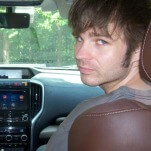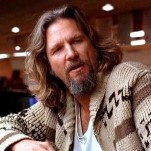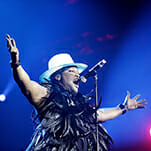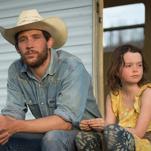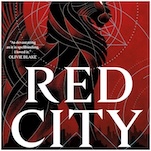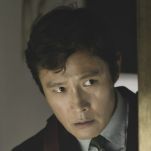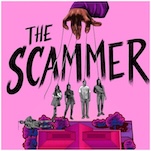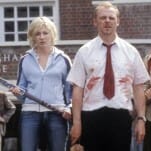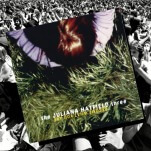The frontman for the funky-cool Venezuelan band Los Amigos Invisibles prances into the spotlight at the 500-capacity Visulite Theatre in Charlotte, N.C., and plays the crowd as if performing to 20,000 people. Jumping about like a Beastie Boy, he grins, grabs his crotch and coos at the bank of beautiful Latinas smashed up against the stage at his feet. Then he sneers.
Julio Briceño is Mick Jagger at the Rock And Roll Circus in 1968, Michael Hutchence in his excessive ’80s heyday, Ian Brown ushering in the flippin’ Britpop movement of the 1990s, Beck mimicking both Prince and Dylan at the turn of the millennium. Like these English-language icons of irony, Briceño turns rock clichés on their heads. Only, for this cockeyed Caracan playboy, old Latin stereotypes fall by the wayside.
Los Amigos Invisibles aren’t the only ones shaking things up in Latin alternative rock: Mexican critical darlings Café Tacuba rewrote the instruction manual on rock en español throughout the ’90s; eclectic Argentine groove merchants Babasonicos bring a brooding, glam-rock sensibility to the Latin alternative scene; Perúvian rockers Libido’s 2003 album, Pop Porn, has a psychedelic feel; and pioneering Mexico City alt-rock band Los Jaguares’ ambitious music merges art, romance and introspection with political and social commentary.
Some of the more interesting Spanish-language rock today comes from strong young women who defy media images of the sexy Latina pop star as mere eye candy for male fantasies. Mexico City post-alternative singer/songwriter Ely Guerra both wails like a Spanish-singing PJ Harvey, then whispers like a Brazilian chanteuse on her 2004 album Sweet & Sour, Hot Y Spicy. Julieta Venegas, born in Southern California but raised in Tijuana, sings over a lilting Spanish guitar and accordion in “Andar Conmigo,” from her 2003 alternative-pop release, Sí, but she fills other songs with funky keyboard parts, electronic bass, wah-wah guitars and vocal effects.
At 38, veteran Colombian singer Andrea Echeverri, of the visionary ’90s art-rock band Los Aterciopelados, is the grand dame of Latin alternative rock. On her new solo debut, she writes and sings candidly about the birth of her baby girl, Milagros, integrating tra- ditional Latin folk songs with electronics and trip-hop underpinnings, African rhythms and brushstrokes of American country music.
In 2005, the most inspired rock isn’t happening in Memphis, London, New York, Los Angeles or Seattle—it’s coming from places like Bogotá, Caracas and Mexico City.
“The Latin alternative scene is growing,” says Guerra, 32, who blames mainstream media and record company myopia for giving U.S. audiences a false sense of Latin popular music’s breadth by historically force-feeding fans English-language crossover artists ranging from Julio Iglesias to Ricky Martin and Thalia. “I believe North Americans got the first impression of Latin music as this pop music which was kind of cheesy, but that wasn’t the whole thing that was happening down here.”
Having bubbled up from underground scenes across Latin America in the 1980s, rock en español began making inroads north of the border in the early ’90s. Until recently, though, the artists’ tours haven’t strayed far in the U.S. beyond traditionally Hispanic-heavy populations in Texas, Southern California, Chicago, New York and Miami.
But that’s changing. In 2002, BMG gambled when it booked Los Jaguares into several cities in the Southeast. Guitarist César “Vampiro” López wondered if Jaguares’ brooding, Spanish-language rock would go over. “I didn’t know that there were big Latino communities in cities such as Charlotte,” says López. “We worried about whether people would show up.” The band members were surprised when Jaguares packed venues like the predominantly Latin club Skándalos in Charlotte. “It feels like there’s Mexicans everywhere [now],” López says. Since then, several other Latin rock acts have done well in clubs across North Carolina, as well as other states not typically thought of as hotbeds of Latin music.
But these aren’t typical times. During the 1990s, the Hispanic population in the U.S. soared 57.9 percent. Much of that growth happened in the South, where between 1990 and 2000, a handful of Southern states—Arkansas, Georgia, North Carolina, South Carolina and Tennessee—saw their Hispanic populations jump more than 200 percent. North Carolina experienced the largest growth by far, with a 394 percent increase. In 1990, the state’s Hispanic population was 76,726; by decade’s end, the number had skyrocketed to nearly 379,000 according to Census Bureau figures. Today, some experts say, North Carolina’s Hispanic population is well over 500,000.
The big-ticket Latin events in the Southeast are arena shows by family-friendly music legends such as mariachi king Vicente Fernández and pop singer Juan Gabriel. But Latin rock does well enough on the club level that even some Anglo venues have begun booking the bands on a regular basis. In the past year, the Visulite has hosted nights by local rock en español band La Rúa, as well as the delicate-sounding New York City-based Brazilian/Anglo trio Mosquitos, the English-language Mexican-American blues-rock trio Los Lonely Boys—and, of course, those playful Caracan lounge lizards of Los Amigos Invisibles.
Midway into Los Amigos’ first song at the Visulite, two young fans sandwiched in the orchestra pit like tourists at the Terminal de Pasajeros unrolled a huge Venezuelan flag for the band to see. It was a show of solidarity and celebration for the growing Latin-rock alliance in this part of the Carolinas, an alliance made up of more than just a few hipsters from Venezuela and Mexico. The area’s most visible Latin American citizens? They’re young people from Argentina, Brazil, Costa Rica, Ecuador and many other countries across Central and South America.
Los Amigos performed a dynamic two-hour set of Latin-flavored dance music with a polyester wink and a nod to American and British rock, disco and kitschy lounge music. The smattering of gringos in the crowd may not have understood Julio Briceño’s playfully sexual lyrics, but they could feel the heat in the sweaty club as Spanish-speaking fans sang along to the songs, jumped up and down, and danced, danced, danced.
Not bad for a Sunday in the Bible Belt.
Historia del rock’n’roll, Vol. 1
For more than 30 years, Spanish-language rock has been popular culture’s best-kept secret—at least, in the English-speaking world. U.S. fans may have occasionally flirted with Latin-tinged rock in the decades since ’50s rocker Ritchie Valens recorded his amped-up version of the Mexican folk song “La Bamba” and Santana transported Tito Puente’s “Oye Como Va” into a smooth, blues-rock scorcher. But tolerance for rock sung in languages other than English has been generally low. After all, Valens’ biggest hit was “Donna” and Santana’s was the spooky Fleetwood Mac cover “Black Magic Woman” (up until “Smooth,” nearly 30 years later).
Meanwhile, a parallel universe of rock ’n’ roll was happening due south. At first, Spanish-language bands simply mimicked the music that rumbled out of Memphis in the late ’50s and the U.K. in the early ’60s. In Mexico, a string of garage bands emerged, with names like Los Locos del Ritmo, Teen Tops and Rebeldes del Rock.
“They didn’t have their own sound,” says Café Tacuba keyboardist Emmanuel “Meme” del Real. “They just did covers of English rock ’n’ roll hits, like Elvis Presley or The Beatles, and translated them into Spanish, or they sang them in English but didn’t really know what they were singing. That was the beginning of rock ’n’ roll in Mexico.”
Similar bands formed in other Latin American countries, including Venezuela (Los Impala, Los 007, Los Darts), Uruguay (Los Shakers, Los Mockers) and Perú (Los Yorks, Los Shains). Brazil had its own wildly experimental rock scene that came to fruition in the mid ’60s with the arrival of bands like Os Mutantes and folk-protest artists such as Caetano Veloso, Gilberto Gil, Maria Bethânia and Tom Zé.
By the late ’60s, Mexican rock bands with English names—Peace and Love, White Ink, The Ritual and Three Souls in My Mind—began branching out and experimenting with their own musical traditions. They grew their hair and lived on the fringes of Mexico’s conservative religious culture.
The country was in transition. In July 1968, young people began taking to the streets of Mexico City in shows of defiance against the government, the likes of which had never been seen before in Mexico. Shaken by these uprisings, authorities cracked down on student demonstrations, resulting in a brutal massacre that fall at the Plaza of the Three Cultures in Tlatelolco. It was Mexico’s version of Kent State or Tiananmen Square, and it forever eroded the trust young people once had in their government. Mexican authorities banned student organizing and suppressed information about government activity, and political activism among young people went underground. Three years later, rock ’n’ roll moved into the government’s periscope when 300,000 young people showed up for the Woodstock-like Festival de Rock y Ruedas de Avándaro outside Mexico City. Authorities soon began cracking down on music, too.
“They thought the concert couldn’t muster up so many people, because there was no support for this kind of rock in the media,” says Jaguares’ Vampiro, who was just two years old when Avándaro took place. Vampiro considers Avándaro the most pivotal moment in the history of rock en español. “There was an underground movement. And that’s when the government got scared,” he says. “And that’s when rock became vilified. They closed the doors on rock. It was something you couldn’t play except for in very secretive places.”
Among the bands that performed at Avándaro was Three Souls in My Mind, fronted by an eccentric musician named Alejandro Lora. Three Souls was one of the more creative groups playing American-style rock ’n’ roll when it formed in the late ’60s. After Mexican President Gustavo Díaz Ordaz began bringing the hammer down on young people who played rock ’n’ roll, Lora and company changed the way they were making music—and they changed their English name to the Spanish El Tri.
“We were forced to go underground,” Lora told the Houston Chronicle last year. “To play in garages, in private homes, in factories, in parking lots.” But he added that the “repression in a way helped us connect more solidly with our fans. The people began to identify with themes in our songs.” Those songs include “Todos Sea Por el Rocanrol” (All For Rock ’n’ Roll) and “Abuso de Autoridad” (Abuse of Authority). After 35 years, El Tri still performs and is known today as Mexico’s most influential rock band.
Throughout the ’70s and early ’80s, rock remained underground in Mexico, but in 1984 authorities lifted their ban on rock concerts, and rock en español entered a new era of creativity. In September 1985, a club called Rockotitlan opened and became the place for new bands to play. Suddenly, Mexico City was getting performances from bands across the Spanish-speaking world, such as Argentina’s Soda Stereo and Los Fabulosos Cadillacs, and Paris-based Spanish punk band Mano Negra. Mexico produced a string of its own bands, including Maldita Vecindad, Caifanes (which later became Jaguares) and Café Tacuba.
Of all this new music, the dramatic, synth-based sound of Caifanes spoke most intimately to the frustrations of Mexican youth in the late 1980s. Drawing from brooding English-language bands like Joy Division, The Cure and The Smiths, Caifanes incorporated Latin styles but fleshed them out with spare and spooky keyboards, swirling flanged guitars and syncopated beats. Singer Saul Hernandez crafted beautiful melodies with lyrics ranging from dark and existential to mythical and spiritual to social and political. As frontman of Jaguares, Hernandez continues to refine Caifanes’ melancholy progressive-rock sound.
The zany Café Tacuba, by contrast, never seemed to take themselves so seriously, and yet their music reveals an ambitiousness rarely heard in rock music from any culture. Beginning in the late ’80s as a ska-influenced punk band, Café Tacuba’s wildly eclectic collision of styles veers from modern takes on traditional Latin forms such as ranchera, tejano and banda, to multi-textured compositions infused with elements of hip-hop, electronica, musique concrete, contemporary classical and roiling alternative pop.
By the early ’90s, after a group once known as Sombrero Verde changed its name to Maná and began recording a more mainstream form of Latin alternative rock, major record companies in the U.S. were seeing dollar signs in the new rock en español movement.
“That was a very huge moment, because that was the beginning of the alternative rock scene as a business,” says Ely Guerra. “Before that, we were doing this music on a more underground level.”
Historia del rock’n’roll, Vol. 2
Guerra was just 15 when she packed her bags and took off for the blaring horns, smog and culture clashes of the world’s then largest metropolis, Mexico City, more than 300 miles from her parents’ home in Guadalajara. Guerra was psyched about joining the burgeoning alternative-rock movement shaking up underground clubs like Rockotitlan.
“I needed to find out why I was playing guitar by myself since I was nine and why I wanted to write my own music and my own songs,” Guerra says from her home in Mexico City. “I believe when I moved to Mexico City as such an early teenager, I needed to be by myself and I needed to live in a very different way than I did with my family.”
Guerra grew up in a colorful family. Her father, Alberto Guerra, was the coach of the famous Guadalajara soccer team Las Chivas; her mother was a housewife and former model. “The whole thing was around soccer, because my dad was a professional and he didn’t have a lot of vacation. That was his life. Being a soccer coach in Mexico is very important. He’s a big personality,” she says. “My mother is another Mexican woman who used to be a professional but stopped working to be ama de casa [housewife].”
Today, Guerra says, she isn’t resentful of her father’s celebrity. “I have no complaints; I love soccer,” she says. “I remember feeling happy when they win. I believe that soccer and music are businesses that you can compare. They come from the heart; you have to be very passionate and very strong, and you have to be very intense.”
Still, Guerra said she had to get away from it to figure out who she was as a young girl. In Mexico City, she moved into a hotel and began writing and singing—and going out to see all the new bands of the late ’80s. “The very first band that I really enjoyed was Mano Negra,” she remembers of the experimental group whose music is a combination of The Clash, Mekons, Gang of Four and zany ’60s-style psychedelia.
It was around that time that Guerra also discovered Café Tacuba. “They blow my brain. They were great,” she says. “The singer, he used to wear all those clothes like indigenous people wear, and he jump around in that particular way he does.”
Guerra wanted a record deal for herself, but she felt inferior because she couldn’t speak English. So she moved to Olympia, Wash., to study at Evergreen State College. It was the early ’90s, and an underground music movement was brewing in the U.S. Pacific Northwest, too. “When I was in Olympia, Nirvana was doing huge things, fighting for their rights to say what they were saying. I was in the middle of that crowd. I was understanding myself, because I had never shared a lot of my way of making music with other musicians. It was a huge time for me up there. I learned a new language; I could be a part of something with Nirvana.”
Guerra began listening to the music of strong female singer/songwriters, from Joni Mitchell to the Indigo Girls and Ani DiFranco. In 1992, Guerra recorded her first album, but it wasn’t until five years later, when she released Pa’ Morirse de Amor, that she began to get some attention for her music—and her looks. Guerra’s beauty became an obstacle to her being taken seriously in the male-dominated world of Latin rock. So she shaved her head.
“Every time I had an interview, they were talking about my pretty face or my pretty body, or they were criticizing me for being too intense,” she says. “I was very upset about that, and I shaved my head. And do you know what? It was the most feminine moment in my life. Even though I was shaved, I saw myself as a very feminine person.”
Rock bands in other Latin American countries—particularly female-fronted bands—experienced similar resistance in the’90s. “Colombia is a very conservative country,” says Andrea Echeverri of Los Aterciopelados, which mixes traditional Latin musical styles such as bolero, flamenco, mariachi and tropical into their experimental rock. On the band’s most famous album, La Pipa de la Paz, the pierced and tattooed Echeverri sings songs with titles like “Chica Dificil” (Difficult Chick), whose lyrics—“I don’t need your approval”—are directed squarely at old-fashioned male attitudes.
“I think people were a bit shocked, not just by the lyrics, but by our images and the way we talked,” Echeverri says of the early responses to the band’s music. “Even now, they get a bit shocked with that.”
Echeverri has moved on from songs about male dominance to the songs on her recent, self-titled solo album about her new child. Now Echeverri feels her new music is a natural outgrowth of maturing. “Every time you make a record, it’s like a photograph of you from that time,” she says. “And we’ve changed. We’ve been playing for more than 13 years and we’ve grown up.” In another song from La Pipa, Echeverri sang that she’d never have a baby because it would ruin her figure. “That song, ‘La Culpable,’ was written by [my musical partner] Hector, and it has some sense of humor. It says I won’t have a baby, and that is a bit funny. I didn’t want to have a baby at that time, but it had nothing to do with my figure.”
Guerra, too, has made peace with her past. Now, with four albums and plenty of rave reviews under her belt, she’s come to terms with both her beauty and her music. “I can have both now: I can be pretty and also be a good musician,” Guerra says. “And it’s important to me to have a good image and to express myself with my body. … I’m happy now that I can be all of that.”
Hisoria del rock’n’roll El Futuro
“Why is it that people all over the world listen to Britney Spears, and they don’t know what she’s saying, but they listen anyway?”
Meme del Real’s question is, of course, rhetorical. The Café Tacuba keyboard man is talking about the reluctance of U.S. rock fans to accept music in other languages. “In other countries, people take music as it comes,” del Real says. “They listen and don’t question. But in the States, people are not used to listening to music this way. They’re used to people singing in their language.”
It’s been damn near impossible for North Americans to change this arrogant old habit. For one thing, children in the U.S. are not pushed to learn different languages. Americans are the Paris Hiltons and Nicole Ritchies of the world—spoiled rich kids advised by politicians and big corporations to have it their own way. But as a recent best-selling author and one-time American rock poet once sang, “The times they are a-changin’.”
As municipalities across the United States become increasingly populated by citizens of Latin American heritage, rock en español is emerging in the unlikeliest of places. Huge cities with large Hispanic populations are no longer the exclusive domains of the simple, organic sounds of rural ranchera or complex rhythms of salsa and merengue. Today, Latin beats and melodies and songs sung in Spanish can be heard coming from pimped-out cars cruising main streets in small towns across America. On Friday nights in my hometown of Asheboro, N.C., the old main drag, Fayetteville Street, once had jacked-up muscle cars with Confederate flags draped across the back windows blaring Lynyrd Skynyrd. Today, Fayetteville Street is lined with Mexican mercados, and you hear the Tejano pop of Thalia or the norteño sound of Los Tigres del Norte coming from the cars.
The breadth of Spanish-language music seeping into U.S. popular culture is awesome. In the world of mainstream rock, Santana’s 1999 comeback album Supernatural coupled with the multi-platinum success of powerful Colombian singer/songwriter Shakira’s 2001 album Laundry Service, indicated a shift in popular taste for Latin music. But Santana’s revived popularity was largely based on his use of popular young American rockers and rappers on the album. And Shakira’s biggest success came only after she chose to sing in English.
“Laundry Service is arguably the first major crossover into the English market by a [primarily] Spanish-speaking artist,” wrote Billboard magazine Latin Bureau Chief Leila Cobo after the album’s release in 2001. “After all, Marc Anthony, Jennifer Lopez, Gloria Estefan and even Enrique Iglesias were either born or raised here, and Ricky Martin was fluent in English for years before his English-language album debut.”
This kind of talk annoys the bilingual Mexican singer/songwriter Julieta Venegas. “When I hear Shakira sing in English, I don’t understand what she’s saying,” says Venegas, pointing to Shakira’s poor command of the language. To Venegas, Shakira’s Spanish-language albums, such as the 1998 classic Dónde Están los Ladrones? , are already top-notch works from a talented singer who caved in to the pressures of the U.S. market. When fans listen to Shakira’s English-language music, says Venegas, “they’re not hearing her as she is. She definitely became more famous, but to me, it’s just weird. I mean, I speak English, but my songs, the way I write them and the way they come out—it’s Spanish. That’s how I tell my stories.” (Diana Baron, the L.A.-based publicist for both Shakira and Venegas, says all the songs on Shakira’s forthcoming U.S. album will be in Spanish.)
Echeverri doesn’t worry about such things, satisfied that her music speaks to scores of Spanish-language fans. While she’s happy that some English-language music lovers in the U.S. have championed her work, when asked if she believes that rock sung in Spanish will ever make significant advances on the U.S. charts, she says, “I don’t know, and I don’t care.”
Guerra agrees that Spanish-speaking singers and songwriters should never leave their own language behind, but she doesn’t take such a hard-line position on the language debate. “We should keep writing in Spanish,” she says, “because this is the nature of our music. And you have no limit in Spanish, there are a lot of options. You can say one thing in so many different and beautiful ways.”
But in today’s global society, Guerra suggests, rock singers and songwriters from all backgrounds should take on the challenge of writing in other languages. “I’m not scared to also write songs in English. I think it’s important to be open,” she says. “I’d love to write in Portuguese, too. But I’ll never leave Spanish. Spanish is my mother language.”










































